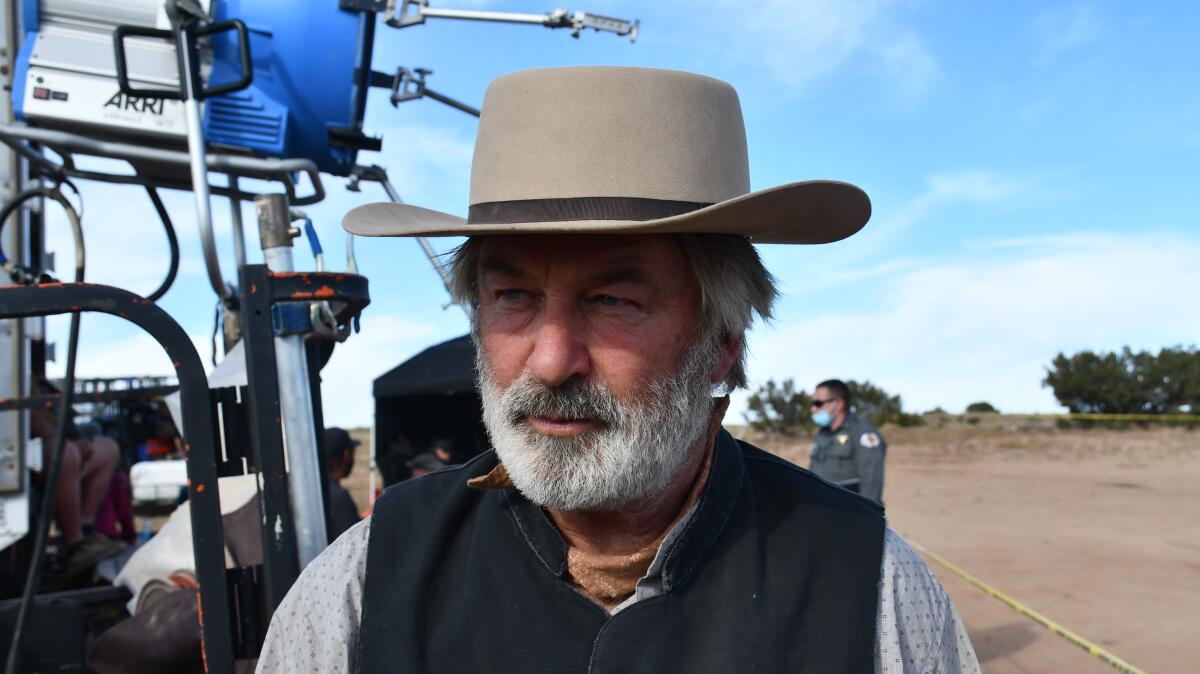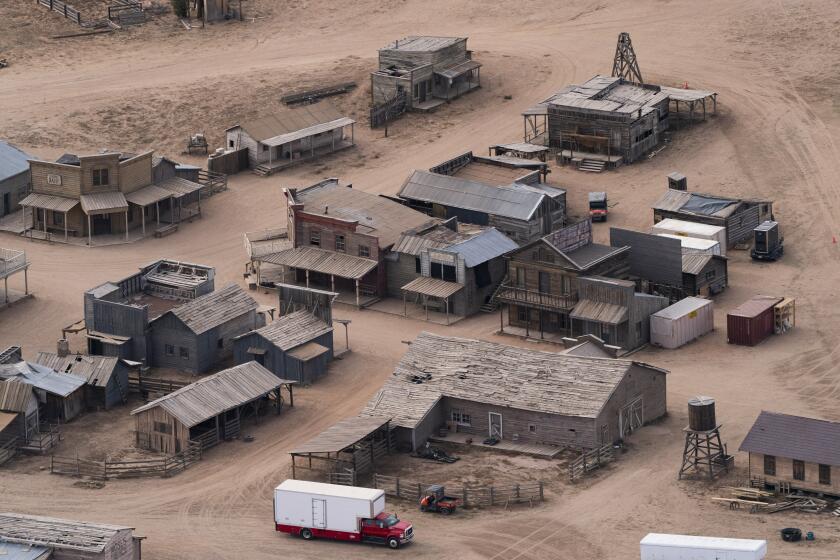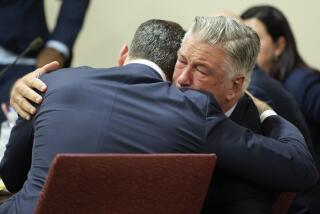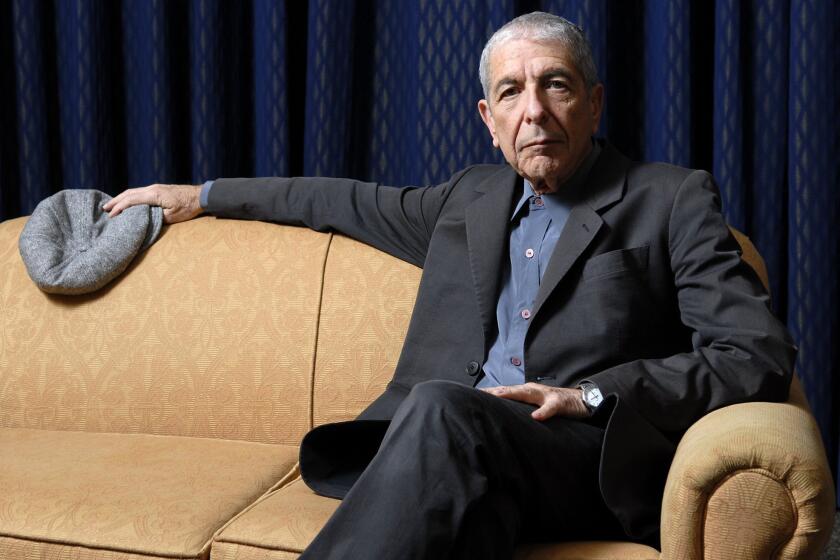FBI’s ‘Rust’ shooting analysis leaves key questions unresolved

- Share via
A long-awaited FBI report, including an analysis of the weapon that Alec Baldwin fired last October on the New Mexico set of “Rust,” resolved some issues but left untouched key questions surrounding the death of cinematographer Halyna Hutchins.
The FBI did not draw any conclusions about where live ammunition came from but concluded that the pistol, a replica of a vintage Pietta Colt .45, “functioned normally when tested in the laboratory.” The report also noted that, in order for the revolver to fire, the trigger needed to be pulled.
The analysis casts doubt on Baldwin’s statements late last year to ABC News’ George Stephanopoulos that he did not pull the trigger.
“With the hammer in the quarter- and half- cock positions, [the revolver] could not be made to fire without a pull of the trigger,” the FBI report said. “When enough pressure was applied to the trigger, each of these safety positions were overcome and the hammer fell. This is consistent with normal operation for a single-action revolver of this design.”
But the report seemed to leave open other possibilities. Even when the gun’s hammer was in the “rest” position, the report said, it could have fired “without a pull of the trigger when the hammer was struck directly.”
ABC News first reported the results of the ballistics test over the weekend, focusing on Baldwin’s role in the tragedy on the low-budget movie set. But the actor and film producer’s New York-based attorney, Luke Nikas, said in a subsequent statement that the report’s conclusions were being “misconstrued.”
“The gun fired in testing only one time — without having to pull the trigger — when the hammer was pulled back and the gun broke in two different places,” Nikas said. “The FBI was unable to fire the gun in any prior test, even when pulling the trigger, because it was in such poor condition.”
Though Alec Baldwin fired the shot that killed Halyna Hutchins on a film set, experts say others who handled the weapon are more likely to be charged.
The debate puts more pressure on New Mexico First Judicial Dist. Atty. Mary Carmack-Altwies to cut through seemingly conflicting evidence in deciding whether criminal charges should be filed in relation to Hutchins’ death. The Santa Fe County Sheriff’s Office said last week that it was waiting for the final pieces of potential evidence — data from Baldwin’s cellphone — before turning the case over to the district attorney.
The FBI analyzed 43 items in its extensive, months-long review, including studying the bullet, which entered Hutchins’ chest and traveled through her body before exiting and lodging in the shoulder of the film’s director, Joel Souza. He had been standing next to Hutchins as the two worked to frame a camera angle during a rehearsal around 1:45 p.m. on Oct. 21, 2021. Hutchins and Souza were planning a close-up of the gun’s barrel and muzzle.
According to law enforcement documents, during that rehearsal in an old wooden church, the film’s assistant director, David Halls, handed Baldwin the pistol, pronouncing it “cold,” meaning there was no ammunition inside. But the gun contained at least one live round.
Baldwin was going through the motions of a cross-draw maneuver when the gun discharged.
“The trigger wasn’t pulled. I didn’t pull the trigger. No, no, no, no, no,” Baldwin told Stephanopoulos in the ABC News interview in December. “I would never point a gun at anyone and pull the trigger at them.”
The FBI tested fingerprints of four individuals, including Baldwin and Halls. It also looked at the prints of the film’s armorer, Hannah Gutierrez Reed, and the film’s prop master, Sarah Zachry, who also handled the guns. Fingerprints were found on key pieces of evidence, including the gun and ammunition boxes.
The FBI report indicated that it uncovered multiple live rounds, contained in cartridges and ammunition boxes on set, in violation of industry protocols that no live bullets be on a movie set.
The autopsy report from the New Mexico Office of the Medical Investigator concluded that Hutchins died of a gunshot wound to her chest. The autopsy was performed the day after the accident, and it labeled Hutchins’ death as accidental.
“The critical report is the one from the medical examiner, who concluded that this was a tragic accident,” Nikas said. “This is the third time the New Mexico authorities have found that Alec Baldwin had no authority or knowledge of the allegedly unsafe conditions on the set, that he was told by the person in charge of safety on the set that the gun was ‘cold,’ and believed the gun was safe.”
How an armorer and a prop master with scant experience wound up in the middle of the Alec Baldwin “Rust” tragedy.
Santa Fe County Sheriff Adan Mendoza has said that his deputies’ criminal investigation has focused on three individuals: Baldwin, Halls — who handed the gun to Baldwin, and Gutierrez Reed.
Gutierrez Reed’s attorney also was critical of the scope of the law enforcement review.
“The FBI reports, while definitive on the revolver question, do not get us any closer to answering the critical question of where the live rounds came from,” said her attorney, Jason Bowles.
Bowles repeated that Gutierrez Reed wasn’t around when the accident occurred, nor had she been called in to the wooden church at Bonanza Creek Ranch to perform “her armorer duties and complete a final safety check.”
Gutierrez Reed was the last person to inspect the gun, according to a previous sheriff’s report. Halls, the film safety officer, allegedly grabbed the gun from a cart outside the church before a small group, including Baldwin, Hutchins and Souza, began the rehearsal, an affidavit stated.
Previous testimony has revealed tensions on set. Gutierrez Reed complained that she was stretched too thin, trying to juggle the demands as armorer in the gun-heavy production and that of assistant prop master. In addition, much of the camera crew had walked off the set hours before the fatal shooting after complaining to the film’s producers about alleged inattention to safety and a refusal to pay for nearby lodging.
More to Read
Inside the business of entertainment
The Wide Shot brings you news, analysis and insights on everything from streaming wars to production — and what it all means for the future.
You may occasionally receive promotional content from the Los Angeles Times.













